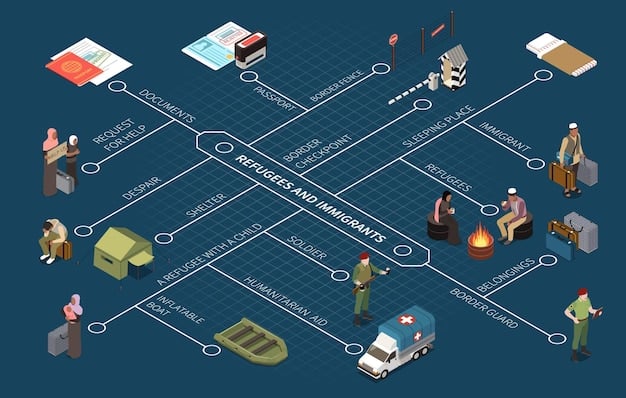Public Safety Reporting: Data Standardization Challenges Across US Agencies

Public Safety Reporting: Addressing the Challenges of Data Standardization Across Agencies highlights the critical need for consistent data standards in public safety, examining the hurdles faced by US agencies and the potential solutions to improve interoperability and information sharing.
The effectiveness of public safety operations hinges on accurate and timely data. However, across the United States, a significant challenge persists: the lack of data standardization among various agencies. Public Safety Reporting: Addressing the Challenges of Data Standardization Across Agencies explores this issue, its impact, and potential strategies for improvement.
The Critical Need for Data Standardization in Public Safety
In the realm of public safety, seamless communication and interoperability are paramount. Data standardization is the cornerstone of these capabilities, allowing different agencies to share information efficiently and effectively. Without it, critical data may be misinterpreted, lost in translation, or simply inaccessible, potentially hindering emergency response efforts.
The absence of standardized data formats can lead to delays, inaccuracies, and ultimately, compromised safety for both first responders and the public. This section delves into why data standardization is vital and how its absence can create significant challenges.
Enhancing Interoperability and Communication
Data standardization fosters interoperability by ensuring that disparate systems can communicate and exchange information without errors. This is crucial when multiple agencies are involved in an incident, as it allows for a comprehensive understanding of the situation.
Improving Decision-Making and Resource Allocation
Standardized data enables better analysis and decision-making. With consistent data formats, agencies can identify trends, allocate resources effectively, and develop proactive strategies to mitigate risks.

However, the reality is that many public safety agencies still grapple with inconsistent data standards. This can result in critical information being overlooked or misinterpreted. The next section will explore the specific challenges that arise from this lack of standardization.
Here are some challenges that arise from the lack of standardization:
- Inaccurate Reporting: Inconsistent data formats can lead to errors in reporting, making it difficult to track trends and identify potential problems.
- Delayed Response Times: When agencies cannot easily share information, response times can be delayed, potentially jeopardizing lives.
- Inefficient Resource Allocation: Without standardized data, it is difficult to accurately assess needs and allocate resources effectively.
Data standardization is not merely a technical issue; it is a fundamental requirement for effective public safety operations. By addressing the challenges associated with data inconsistency, agencies can improve communication, enhance decision-making, and ultimately, better protect the communities they serve.
Challenges in Achieving Data Standardization
Despite the recognized benefits, achieving data standardization across public safety agencies is a complex undertaking. Several factors contribute to this challenge, ranging from technological limitations to organizational inertia and funding constraints.
This section examines the key obstacles that hinder data standardization efforts and explores the reasons why progress has been slow in many jurisdictions.
Legacy Systems and Technological Barriers
One of the primary challenges is the prevalence of legacy systems that were not designed to interoperate with modern technologies. Upgrading or replacing these systems can be costly and disruptive, making agencies hesitant to embrace change.
Lack of Funding and Resources
Data standardization initiatives often require significant investments in technology, training, and personnel. Many public safety agencies, particularly those in smaller or rural jurisdictions, lack the financial resources to implement comprehensive standardization programs.

Organizational and Political Hurdles
Data standardization can also be impeded by organizational and political factors. Different agencies may have their own priorities and perspectives, making it difficult to reach consensus on common data standards. Moreover, concerns about data privacy and security can further complicate the process.
Overcoming these challenges requires a multifaceted approach. Here are some strategies that can help agencies achieve data standardization:
- Develop a Clear Roadmap: Agencies should develop a clear roadmap that outlines the steps needed to achieve data standardization, including timelines, milestones, and resource requirements.
- Seek External Funding: Grant programs and other funding opportunities can provide the financial support needed to implement data standardization initiatives.
- Foster Collaboration: Collaboration among agencies is essential to reach consensus on common data standards and share best practices.
Achieving data standardization is not a quick fix. It requires a long-term commitment and a willingness to embrace change. However, the benefits of standardization – improved communication, enhanced decision-making, and greater public safety – make it a worthwhile endeavor.
Strategies for Effective Data Standardization
To overcome the challenges and achieve meaningful data standardization, public safety agencies need to adopt proactive and comprehensive strategies. These strategies should address not only the technical aspects of data standardization but also the organizational and cultural factors that can influence its success.
This section explores several key strategies that can help agencies effectively standardize their data practices and improve interoperability.
Adopting National Standards and Frameworks
One of the most effective strategies for data standardization is to adopt national standards and frameworks, such as the National Information Exchange Model (NIEM) and the Global Justice Information Sharing Initiative (GJXDM). These standards provide a common vocabulary and data structure that can facilitate interoperability among agencies nationwide.
Standards and frameworks create a common language. Adopting them provides a reliable and proven method for collecting, sharing, and interpreting data. They also offer a consistent format for reporting, analysis, and decision-making.
Investing in Data Governance and Management
Data governance involves establishing policies, procedures, and responsibilities for managing data assets. Effective data governance ensures that data is accurate, consistent, and accessible to those who need it. Data management encompasses the technical processes and tools used to collect, store, and maintain data.
The main goals of Data Governance are to:
- Improve Data Quality: Implement data validation procedures to ensure data accuracy and completeness.
- Enhance Data Security: Establish access controls and security protocols to protect sensitive data from unauthorized access.
- Promote Data Sharing: Develop policies and procedures that encourage data sharing among agencies while respecting privacy concerns.
Implementing Data Integration and Exchange Platforms
Data integration and exchange platforms enable agencies to share information in real-time. These platforms can translate data from different systems into a common format, allowing agencies to access and use the data regardless of its source.
Through a unified platform, users can access, analyze, and share data more efficiently. Benefits include:
By implementing these strategies, public safety agencies can make significant progress toward data standardization and improve their ability to protect the communities they serve. The next section will dive into how technology plays a critical role in these efforts.
- Efficient Data Transfer: Automated processes reduce manual effort and the risk of errors.
- Enhanced Data Accuracy: Real-time data validation improves accuracy and consistency.
- Improved Collaboration: Increased interoperability promotes better collaboration among agencies.
The Role of Technology in Data Standardization
Technology plays a pivotal role in enabling data standardization, offering tools and solutions to streamline data collection, integration, and exchange. From advanced data analytics platforms to secure cloud-based storage, technology can help public safety agencies manage and standardize their data more effectively.
This section explores the specific technological solutions that are driving data standardization and improving interoperability among public safety agencies.
Data Analytics and Visualization Tools
Data analytics and visualization tools enable agencies to analyze large datasets and identify trends and patterns. These tools can help agencies make data-driven decisions, allocate resources effectively, and develop proactive strategies to mitigate risks.
The benefits of data analytics include:
- Improved Situational Awareness: Visualizing data in real-time provides a clearer understanding of ongoing events.
- Enhanced Crime Analysis: Identifying crime patterns and hotspots allows for more targeted policing.
- Better Resource Allocation: Analyzing data on incident types and locations enables more efficient resource deployment.
Cloud-Based Data Storage and Management
Cloud-based data storage and management solutions offer a secure and scalable way to store and manage data. These solutions can help agencies reduce costs, improve data accessibility, and enhance data security.
A major advantage of cloud storage is:
- Data Accessibility: Authorized users can access data from anywhere with an internet connection.
- Scalability: Cloud storage can easily scale to meet the growing data needs of public safety agencies.
- Cost Savings: Cloud-based solutions reduce the need for expensive on-premises infrastructure.
Embracing technological solutions is essential for achieving data standardization in public safety. By leveraging these tools, agencies can improve data quality, enhance interoperability, and make more informed decisions.
Mobile Data Collection and Reporting
Mobile data collection and reporting tools enable first responders to collect and transmit data in real-time. These tools can improve data accuracy, reduce paperwork, and streamline reporting processes.
These reporting tools support:
The next section delves into the crucial aspect of data privacy and security in the context of data standardization. Ensuring that data is protected is fundamental to maintaining public trust and adhering to legal requirements.
- Real-Time Updates: Data collected in the field is immediately available to decision-makers.
- Improved Accuracy: Mobile devices can capture data more accurately than traditional methods.
- Streamlined Reporting: Automated reporting processes reduce administrative burden.
Ensuring Data Privacy and Security
While data standardization offers numerous benefits for public safety agencies, it also raises important questions about data privacy and security. Protecting sensitive information from unauthorized access and misuse is paramount, and agencies must implement robust safeguards to ensure data privacy and security.
This section examines the key considerations for data privacy and security in the context of data standardization and explores the best practices for protecting sensitive information.
Implementing Access Controls and Authentication
Access controls and authentication mechanisms restrict access to data based on roles and responsibilities. By implementing these controls, agencies can ensure that only authorized personnel can access sensitive information.
This can be achieved through:
- Multi-Factor Authentication: Requiring multiple forms of identification adds an extra layer of security.
- Role-Based Access Control: Assigning access privileges based on job roles ensures that users only have access to the data they need.
- Regular Audits: Conducting regular audits helps identify and address potential security vulnerabilities.
Encrypting Data in Transit and at Rest
Encryption protects data by converting it into an unreadable format that can only be deciphered with a decryption key. Encrypting data both in transit and at rest ensures that sensitive information is protected from unauthorized access, even if it is intercepted or stolen.
Additional security measures include:
- End-to-End Encryption: Data is encrypted from the moment it is created until it is accessed by the intended recipient.
- Secure Key Management: Proper management of encryption keys is essential to maintain data security.
- Compliance with Standards: Adhering to recognized encryption standards ensures that data is protected using industry-best practices.
Complying with Privacy Regulations and Laws
Public safety agencies must comply with various privacy regulations and laws, such as the Health Insurance Portability and Accountability Act (HIPAA) and the California Consumer Privacy Act (CCPA). Compliance with these regulations ensures that agencies protect the privacy rights of individuals and avoid costly penalties.
Ensuring compliance requires:
Securing data requires a coordinated effort that encompasses people, processes, and technology. The agencies that prioritize data privacy and security build trust. The next section reviews the challenges and benefits.
- Data Minimization: Collecting only the data that is necessary for a specific purpose.
- Data Retention Policies: Establishing policies for how long data is stored and when it should be deleted.
- Transparency and Accountability: Being transparent about how data is collected, used, and shared.
The Future of Data Standardization in Public Safety
The future of data standardization in public safety is promising, with ongoing efforts to develop and implement national standards, promote data governance, and leverage technology to improve interoperability. As public safety agencies increasingly recognize the importance of data standardization, it is likely that progress will accelerate in the years to come.
This section explores the emerging trends and future directions in data standardization and examines the potential impact on public safety operations.
Increased Adoption of Artificial Intelligence (AI) and Machine Learning (ML)
AI and ML technologies can analyze large datasets, identify patterns, and predict future events. These technologies can help public safety agencies make more informed decisions, allocate resources effectively, and respond to emergencies more quickly and efficiently.
The benefits of AI and ML include:
- Predictive Policing: Analyzing crime data to predict where crime is likely to occur.
- Automated Threat Detection: Using AI to identify potential threats and alert authorities.
- Enhanced Situational Awareness: Providing real-time insights into ongoing events.
Greater Emphasis on Data Sharing and Collaboration
Data sharing and collaboration among public safety agencies are becoming increasingly important. By sharing data, agencies can gain a more comprehensive understanding of crime trends, terrorist threats, and other public safety issues. Collaboration can help agencies develop more effective strategies and coordinate their efforts more efficiently.
The success of these platforms relies on:
- Secure Data Sharing Platforms: Providing secure and reliable platforms for sharing data among agencies.
- Data Sharing Agreements: Establishing agreements that define the terms and conditions for data sharing.
- Training and Education: Providing training to help agencies use data effectively and collaborate with other agencies.
Development of Next-Generation 911 (NG911) Systems
NG911 systems are designed to improve emergency response by providing dispatchers with more information about callers, including their location, medical history, and other relevant data. These systems can also transmit data and multimedia information, such as photos and videos, to first responders in the field.
The promise of NG911 includes:
The future of data standardization in public safety is bright, with ongoing efforts to develop and implement new standards, promote data governance, and leverage technology to improve interoperability. By embracing these trends, public safety agencies can improve their ability to protect the communities they serve.
- Improved Location Accuracy: Providing more accurate location information for callers in distress.
- Enhanced Communication: Enabling dispatchers to communicate with callers via text, video, and other multimedia channels.
- Faster Response Times: Expediting emergency response by providing first responders with the information they need to respond quickly and effectively.
| Key Point | Brief Description |
|---|---|
| 🔑 Data Standardization | Ensures consistent data formats for effective communication and interoperability among agencies. |
| 🛡️ Data Privacy & Security | Implementing access controls and encryption to protect sensitive information and comply with regulations. |
| 🚀 Technology Adoption | Leveraging data analytics, cloud storage, and mobile tools to enhance data management and decision-making. |
| 🤖 AI & ML | Adopting AI and machine learning for predictive policing and threat detection. |
Frequently Asked Questions (FAQ)
▼
Data standardization in public safety refers to the process of ensuring that all data collected and shared by different agencies is in a consistent format. This consistency ensures that agencies can accurately interpret and use the data, fostering interoperability.
▼
Data standardization is crucial for enhancing communication, improving decision-making, and ensuring effective resource allocation. Consistent data allows agencies to share critical information seamlessly, leading to better emergency response outcomes.
▼
Challenges include legacy systems, limited funding, and organizational barriers. Many agencies use outdated technology, lack resources for upgrades, and may struggle to reach consensus on common data standards due to differing priorities.
▼
Technology offers data analytics, cloud storage, and mobile data collection tools that streamline data management. These tools enhance interoperability and improve decision-making by ensuring data is accurate, accessible, and consistently formatted.
▼
Key considerations include implementing access controls, encrypting data, and complying with privacy regulations such as HIPAA and CCPA. Protecting sensitive information is essential for maintaining public trust and adhering to legal requirements.
Conclusion
Addressing the challenges of data standardization in public safety reporting is essential for fostering seamless communication, improving decision-making, and protecting communities. By adopting national standards, investing in data governance, and leveraging technology, agencies can enhance interoperability and ensure data privacy, ultimately leading to more effective and coordinated public safety efforts across the United States.





